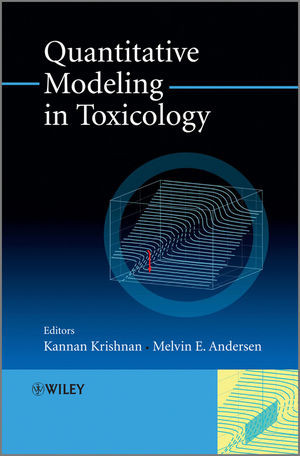

Most ebook files are in PDF format, so you can easily read them using various software such as Foxit Reader or directly on the Google Chrome browser.
Some ebook files are released by publishers in other formats such as .awz, .mobi, .epub, .fb2, etc. You may need to install specific software to read these formats on mobile/PC, such as Calibre.
Please read the tutorial at this link: https://ebookbell.com/faq
We offer FREE conversion to the popular formats you request; however, this may take some time. Therefore, right after payment, please email us, and we will try to provide the service as quickly as possible.
For some exceptional file formats or broken links (if any), please refrain from opening any disputes. Instead, email us first, and we will try to assist within a maximum of 6 hours.
EbookBell Team

4.4
92 reviewsIn Quantitative Modeling in Toxicology leading experts outline the current state of knowledge on the modeling of dose, tissue interactions and tissue responses. Each chapter describes the mathematical foundation, parameter estimation, challenges and perspectives for development, along with the presentation of a modeling template. Additionally, tools and approaches for conducting uncertainty, sensitivity and variability analyses in these models are described. Topics covered include:
A website containing computer codes accompanies the book to help the reader reconstruct the models described and discussed in the various chapters.
Quantitative Modeling in Toxicology serves as an essential reference source and tool box for risk assessors and researchers and students in toxicology, public health, pharmacology, and human toxicology interested in developing quantitative models for a better understanding of dose-response relationships.Content:
Chapter 1 Quantitative Modeling in Toxicology: An Introduction (pages 1–18): Dr Melvin E. Andersen and Dr. Kannan Krishnan
Chapter 2 PBPK Modeling: A Primer (pages 19–58): Dr. Kannan Krishnan, George D. Loizou, Martin Spendiff, John C. Lipscomb and Dr Melvin E. Andersen
Chapter 3 Pharmacokinetic Modeling of Manganese – An Essential Element (pages 59–82): Andy Nong, Michael D. Taylor, Miyoung Yoon and Dr Melvin E. Andersen
Chapter 4 Physiologically Based Modeling of Pharmacokinetic Interactions in Chemical Mixtures (pages 83–105): Sami Haddad, Robert Tardif, Jonathan Boyd and Kannan Krishnan
Chapter 5 Physiological Parameters and Databases for PBPK Modeling (pages 107–134): Douglas O. Johns, Elizabeth Oesterling Owens, Chad M. Thompson, Babasaheb Sonawane, Dale Hattis and Dr. Kannan Krishnan
Chapter 6 Modeling Cholinesterase Inhibition (pages 135–165): Charles Timchalk, Paul M. Hinderliter and Torka S. Poet
Chapter 7 Modeling of Protein Induction and Dose?Dependent Hepatic Sequestration (pages 167–179): Andy Nong and Dr Melvin E. Andersen
Chapter 8 Bistable Signaling Motifs and Cell Fate Decisions (pages 181–198): Sudin Bhattacharya, Qiang Zhang and Dr Melvin E. Andersen
Chapter 9 Ultrasensitive Response Motifs in Biochemical Networks (pages 199–217): Qiang Zhang, Sudin Bhattacharya, Courtney G. Woods and Dr Melvin E. Andersen
Chapter 10 Gene and Protein Expression – Modeling Nested Motifs in Cellular and Tissue Response Networks (pages 219–233): Dr Melvin E. Andersen, Qiang Zhang and Sudin Bhattacharya
Chapter 11 Modeling Liver and Kidney Cytotoxicity (pages 235–250): Kai H. Liao, Yei M. Tan, Harvey J. Clewell and Dr Melvin E. Andersen
Chapter 12 Computational Model for Iodide Economy and the HPT Axis in the Adult Rat (pages 251–267): Jeffrey W. Fisher and Eva D. McLanahan
Chapter 13 Two?Stage Clonal Growth Modeling of Cancer (pages 269–282): Rory B. Conolly and Dr Melvin E. Andersen
Chapter 14 Statistical and Physiological Modeling of the Toxicity of Chemicals in Mixtures (pages 283–297): Hisham A. El?Masri, Michael A. Lyons and Raymond S. H. Yang
Chapter 15 (Q)SAR Models of Adverse Responses: Acute Systemic Toxicity (pages 299–314): Mark T. D. Cronin, Yana K. Koleva and Judith C. Madden
Chapter 16 Modeling Exposures to Chemicals from Multiple Sources and Routes (pages 315–351): Panos G. Georgopoulos, Sastry S. Isukapalli and Dr. Kannan Krishnan
Chapter 17 Probabilistic Reverse Dosimetry Modeling for Interpreting Biomonitoring Data (pages 353–369): Yu?Mei Tan and Harvey J. Clewell
Chapter 18 Quantitative Modeling in Noncancer Risk Assessment (pages 371–398): Q. Jay Zhao, Lynne Haber, Melissa Kohrman?Vincent, Patricia Nance and Michael Dourson
Chapter 19 Application of Physiologically Based Pharmacokinetic Modeling in Health Risk Assessment (pages 399–428): Harvey J. Clewell
Chapter 20 Uncertainty, Variability, and Sensitivity Analyses in Simulation Models (pages 429–458): Sastry S. Isukapalli, Martin Spendiff, Panos G. Georgopoulos and Dr. Kannan Krishnan
Chapter 21 Evaluation of Quantitative Models in Toxicology: Progress and Challenges (pages 459–475): Dr. Kannan Krishnan and Dr Melvin E. Andersen